Health, Safety and Environment Bulletin Sep 2018
Poorly Maintained Pilot Ladder Results in Rapid Transfer
Narrative
Three engineering technicians were preparing to disembark from a 180m long bulk carrier that was departing from port. The technicians had completed works on the ship during its outbound river passage.
The bulk carrier was in ballast with a freeboard of more than 11.5m. At the pilot’s request the ship’s crew had rigged a combination ladder on the starboard side, comprising an accommodation ladder and pilot ladder. A pilot boat came alongside with the intention of embarking the three technicians followed by the port pilot. The ship’s bosun and an OS were at the ladder to supervise the disembarkation.
The three technicians proceeded to walk down the accommodation ladder to the top of the pilot ladder. With the pilot boat in position alongside the ship’s side, the first technician began to descend the pilot ladder.
The first technician was about 1.5m from the pilot boat’s deck when the second technician stepped onto the pilot ladder. The pilot ladder immediately failed. Both of the ladder side ropes parted, and both technicians fell approximately 1.5m and 7m respectively (Figure 1). Both were subsequently taken to hospital by ambulance, but fortunately neither sustained serious injuries.
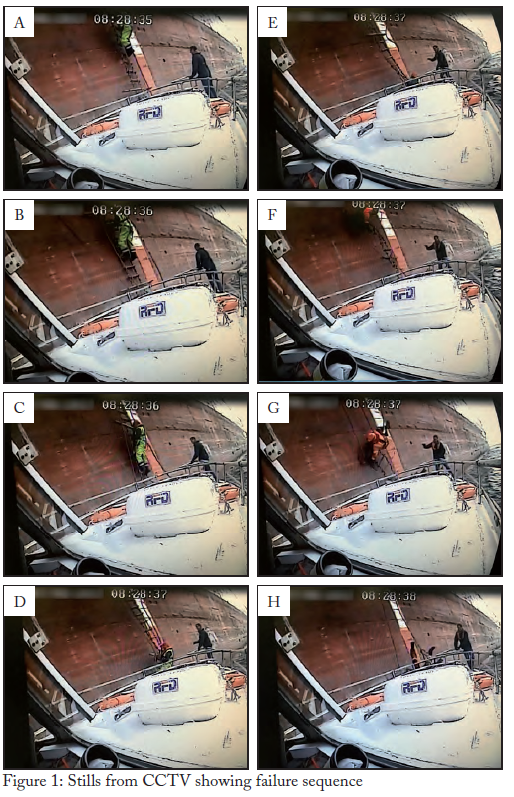
The pilot ladder that had failed was only 15 months old. An internal investigation by the company found that the pilot ladder side ropes had failed through exposure to salt deposits and sunlight (Figure 2), which the ship’s crew had not identified.
The Lessons
- The IMO Convention for Safety of Life at Sea (SOLAS) Chapter V, Regulation 23, sets out the principal requirements for the rigging of pilot ladders. This regulation states that ‘Pilot ladders shall be kept clean, properly maintained and stowed and shall be regularly inspected to ensure that they are safe to use. They shall be used solely for the embarkation and disembarkation of personnel.
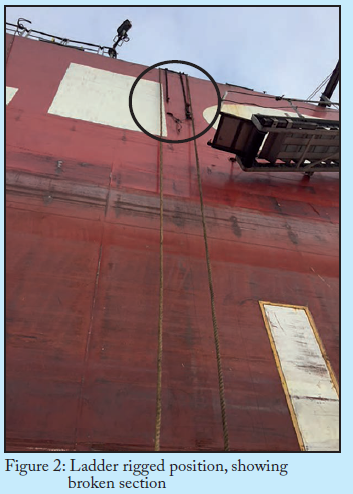
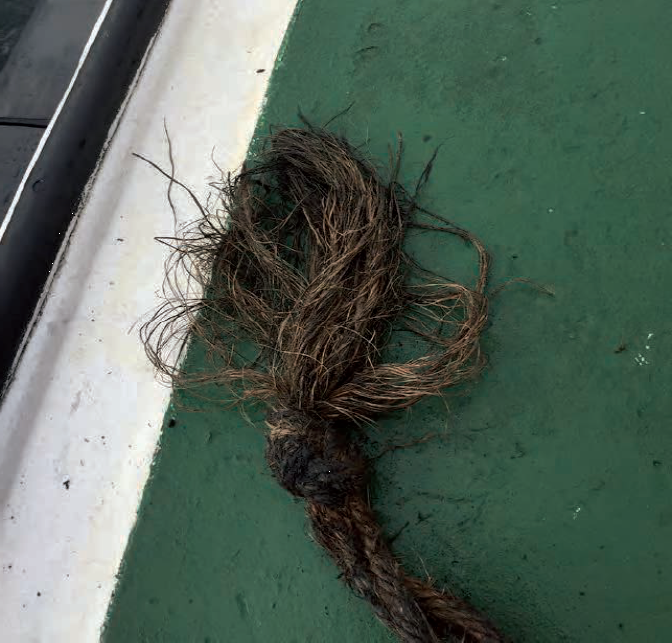
Figure 3: Ladder side rope showing contamination
- In this case, the relatively new pilot ladder had not been properly maintained and stowed, and deterioration to the pilot ladder side ropes had not been identified. Do not store ladders on an open deck where the ropes are exposed to contaminants or elements that can degrade the ropes (Figure 3). After use, ladders should ideally be hung up clear of the deck and stored wherever possible in a clean, dry environment. They must also be protected from oil, chemicals, paint, or any other source of contamination that could affect their strength.
- Routine maintenance inspections of pilot ladders should be a part of the ship’s planned maintenance system. Inspections should include opening the rope splice to view the internal state of the material.
- The SOLAS convention also states that ‘embarkation of a pilot shall be supervised by a responsible officer having means of communication with the navigation bridge’. In this case a responsible officer was not monitoring the transfer of personnel to the pilot boat.
- Pilot ladders should never be used by more than one person at a time. Use by multiple persons may overload the ladder and may cause it to move
(Source: MAIB Safety Digest 1/2018)
Serious Eye Injury during FW Steriliser Maintenance
Vessel Type: General cargo
Incident description
The incident occurred while two of the vessel’s engineers were performing maintenance on the U.V. steriliser of the fresh water generator in port. The work involved replacing a U.V. lamp and its associated tubular quartz glass sleeve within the cylindrical steriliser casing. After the old lamp and sleeve were removed and the new sleeve installed, the engineers decided to hydrostatically test the steriliser unit to verify that the sleeve was correctly fitted and not leaking before installing the lamp. As a precaution against over-pressurising the unit, a vent was said to have been opened on top of the casing as well as a by-pass valve before opening the water inlet valve. After the inlet valve was opened, one of the engineers positioned his head above the open top of the steriliser casing to look into the sleeve. At that moment, the glass sleeve violently imploded, forcefully blowing glass fragments into the face and eye of the engineer. The injured engineer was quickly transferred to a local hospital where doctors were unfortunately unable to save the sight in the affected eye.
Analysis
This is one of a number of accidents notified to the Club relating to the explosive failure of glass fittings, pressure gauge glasses, manometers and light bulbs resulting in serious injuries to crew. Although the vent and by-pass valves were found to be open during the subsequent investigation, excessive pressure had evidently been able to build up within the casing around the glass sleeve, causing it to shatter. It was reported that the injured engineer was not wearing any face or eye protection when carrying out the work, despite the ready availability of this equipment in the engine room. If the engineers had performed a proper risk assessment and toolbox talk prior to carrying out the task, this would have given them the opportunity of identifying the potential hazards associated with the job and what precautions were required to minimise risk to personnel.
Lessons Learnt
- Always perform a proper risk assessment and pre-work toolbox talk when work is to be carried out on pressurised systems or on fragile components that could potentially fail, exposing crew to injury
- Reference should be made to the relevant SMS instructions, safety precautions and checklists prior to commencement of any maintenance work
- Ensure that appropriate PPE is worn at all times including full face visors and goggles as appropriate to the assessed risk
- When performing maintenance, always refer to the manufacturer’s instructions and observe recommended safety precautions
(Source: UK P&I Club)
Refrigeration Plant Hazard
Vessel Type: Bulk Carrier
Incident description
During a third party survey, the surveyor made a request to test the emergency fire pump, which was arranged with the assistance of the Chief Engineer. The emergency fire pump was located in a recessed well in the steering gear compartment, approximately 3 metres deep and accessed by an inclined stairway. At the commencement of the test, the surveyor asked to observe the pump being started locally and operating before proceeding on deck to check the hoses rigged fore and aft. Shortly after descending into the fire pump well, the Chief Engineer urgently ordered the surveyor to get out and by the time both men reached the steering compartment deck, they were experiencing symptoms of dizziness, with the Chief Engineer in a state of near collapse. They were taken on deck into fresh air by other crew members and recovered soon afterwards.
Analysis
Investigation into the cause of the incident revealed that maintenance had recently been carried out on the provision store refrigeration machinery located in the steering flat. During this work, Freon refrigerant gas from the plant must have been released into the space and, being heavier than air, had migrated into the pump well displacing breathable air. Both men were very fortunate to escape from the space unharmed. If the ladder had not been inclined but vertical, as is more usually the case, they may not have exited the well before passing out. The Chief Engineer was possibly more affected due to being of shorter stature than the surveyor and thus inhaling a higher concentration of the gas.
Lessons Learnt
- Improper maintenance procedures can cost lives. Refrigerant gas should be contained and in the event of accidental release, the immediate area and adjacent spaces must be checked and thoroughly ventilated
- This is not an isolated incident involving Freon charged refrigeration plant. Ship managers should ensure that crew are made fully aware of the hazards associated with these systems
- Where refrigeration machinery is present in a steering flat or other confined space, a risk assessment should be carried out to determine whether the space is to be treated as an “enclosed space” requiring pre-entry precautions and atmosphere tests
- Consideration may be given to providing fire pump wells of this type with mechanical ventilation extraction from the bottom of the space and if fitted, to ensure it is always operated before entry
(Source: UK P&I Club)
Fatigue and the modern seafarer
Quality of sleep can be as important as quantity in reducing fatigue and sleep quality can be affected by sleep disorders. Should owners and crew managers be taking a closer look at the sleep apnea diagnosis and available treatment responses? The answer appears to be a resounding yes!
As is well documented, “fatigue degrades a person’s cognitive skills by slowing reaction time, reducing vigilance, and adversely affecting decision making, all skills necessary for effective navigation and vessel system diagnosis. Research has shown that people need about eight hours of sleep a day and receiving less than that can lead to fatigue-degraded performance. Accident investigations have linked mariner errors to their fatigue.” (Fatigue in Marine Accident Investigations, Barry Strauch; ScienceDirect, 2015.)
Fatigue related accidents are as significant a problem today as they were in 2002 when GARD first published an Insight article on the topic: Are we tired of hearing about fatigue-related casualties?
Fatigue is caused by a range of factors such as stress and excessive work load but is also very much affected by a person’s ability to “sleep well”. In addition to environmental factors such as noise and vibrations, a seafarer’s quality, quantity and continuity of sleep is very much affected by the typical onboard work schedules. Accordingly, fatigue management strategies commonly begin with determining operational workload requirements and matching onboard manning levels and onshore support resources, combined with efficient management of workload and hours of work and rest on board the ship.
However, a variety of sleep disorders are also known to disrupt the quality of sleep and make it impossible to obtain restorative sleep, even when individuals spend enough time trying to sleep. The most common sleep disorders are sleep apnea, insomnia, restless legs syndrome, shiftwork sleep disorder and narcolepsy. Sleep disorders pose a particular risk for seafarers, as maritime operations already expose seafarers to restricted sleep.
With studies concluding that fatigue plays a significant role in marine casualties, it is no surprise that the shipping industry is looking for an evidence-based response plan. Here we discuss sleep apnea – a disorder which often goes undetected and therefore untreated – to the detriment of individual crew members and, inevitably, to the safe operation of the vessel.
Sleep Disorder Breathing (SDB) describes two main disorders:
- Obstructive Sleep Apnea (OSA) which is characterized by repeated episodes of upper airway obstruction during sleep.
- Central Sleep Apnea (CSA) which is characterized by a lack of respiratory drive, resulting in breathing instability and pauses. CSA is associated with patients with existing cardiovascular or neurological diseases.
We will focus on the first disorder, OSA, as it is by far the most common. As is well documented in the medical journals, OSA has a significant causative correlation with arterial hypertension, cardio-vascular disease, coronary heart disease and an independent risk factor for stroke. There is additional medical research indicating possible connections to atrial fibrillation, heart failure and diabetes (further studies are being done). All these illnesses are serious, leading to very significant disability and an untimely death.
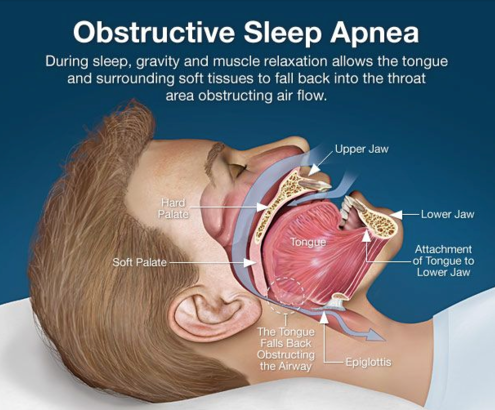
Image: Obstructive Sleep Apnea
Diagnosis, treatment and loss prevention
Proper diagnosis of OSA is simple, involving only one night of sleep connected to sensory medical equipment. Once the diagnosis is made, treatment is also simple and effective. The C-PAP machine is the primary medical tool and is available world-wide. The C-PAP is a mask worn at night connected to a machine which intakes air, pushes it down the connecting tube and into the mask. The resulting increase in air pressure forces the patient’s airway open and keeps it open so long as the machine senses the blockage in the throat (which is done by measuring the relative pressure of in breaths and out breaths).
Another tool to address sleep apnea is a custom-made dental retainer which forces the lower jawbone upwards and away from the throat area, thereby increasing the radius of the airway and minimizing closure during sleep. Both tools have been shown to reduce obstructive airways when used properly. Both are easy to transport when a seafarer travels to and from the vessel.
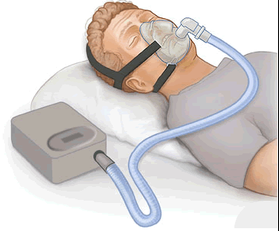 Image: C-PAP Machine
Image: C-PAP Machine
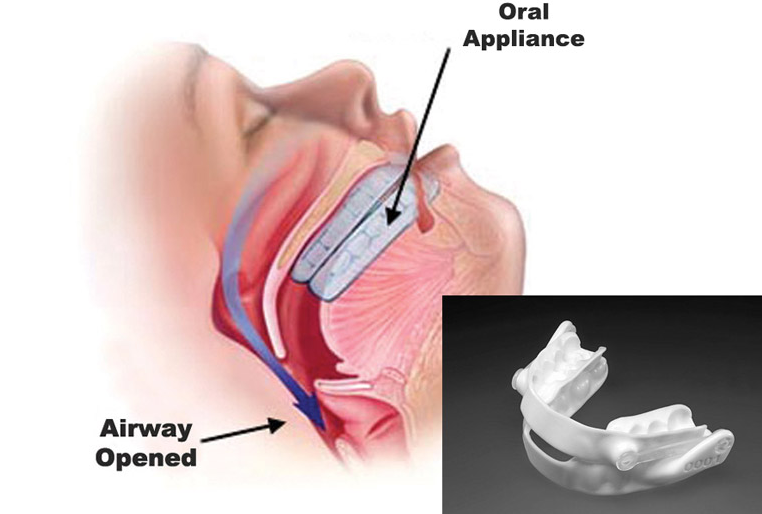 Image: Dental Retainer
Image: Dental Retainer
It is also worth noting that the IMO Sub-Committee on Human Element, Training and Watchkeeping (HTW) has finalized a set of revised guidelines on fatigue which will, pending approval by the Maritime Safety Committee (MSC) during its next meeting in December 2018, assist shipowners and operators in tuning their fatigue management strategy. When adjustment to manning levels, operational workload requirements and rest periods do not reduce fatigue in an individual case, we recommend that the employer consider testing for sleep apnea and, if found, provide the C-PAP or retainer to those who suffer from this sleep disorder. Treating sleep apnea will not only improve the quality of life for the individual seafarer. It will also make the ship operations more safe for all those on board and should hopefully reduce the occurrence of casualties that are due to human error.
(Source: GARD, Images: Google)
Unlabelled Containers: Chemicals stored in Drinking Water Bottles
What Happened
One of our members has noted a trend of chemicals being decanted into un-labelled clear plastic water bottles of the sort commonly used for drinking water, and persons have assumed the chemicals to be water and taken a drink from the bottle. Our member noted two recent cases; in one case, a person ingested a small amount of the chemical; in the other, a person took a sip from the bottle but did not swallow any chemical.
Poor hazard awareness;What went wrong/ causes
- Inappropriate and inadequate management of chemicals, putting the health and safety of employees at risk.
Storing chemicals in un-labelled containers presents an avoidable risk, especially when chemicals are placed into containers such water bottles or soft drinks bottles. Accidental poisoning could result in serious harm. If unidentified chemicals are accidentally ingested, medical staff may not be able to administer the appropriate treatment in a timely manner, with potentially fatal consequences.
Lessons Learnt
- Chemicals are often ordered in bulk quantities and may arrive in containers that are too large or heavy for everyday use. Subsequently the chemicals may be transferred to smaller containers that are easier to manage;
- If it is necessary to decant chemicals from their original containers:
- Always decant the chemicals in the chemical storage area
- Use a container in good condition, of type appropriate for the chemical
- Ensure that both containers are clearly labelled. The labels should be clean and legible and should include:
- full product name
- Manufacturer name
- safety data sheet (SDS) reference
- Do not use bottles normally used for, or associated with, drinking water
- Wear the correct personal protective equipment including gloves and protective eyewear;
- Storage of chemicals should be in accordance with the SDS and in a designated and properly controlled storage location;
- Persons dealing with chemicals should be fully aware of relevant SDS information and local regulatory requirements such as the Control of Substances Hazardous to Health (COSHH (UK)).
(Source: IMCA Safety Flash 29/17)
First Tanker Utilising Wind Propulsion
Norsepower Oy Ltd., together with project partners Maersk Tankers, Energy Technologies Institute (ETI) and Shell Shipping & Maritime, announced the installation of two Norsepower Rotor Sails onboard ‘Maersk Pelican’, a Maersk Tankers Long Range 2 (LR2) product tanker vessel, targeting an emissions reduction of 7-10%.
The Rotor Sails are large, cylindrical mechanical sails that spin to create a pressure differential – called the Magnus effect – that propels the vessel forward. The Rotor Sails will provide auxiliary wind propulsion to the vessel, optimizing fuel efficiency by reducing fuel consumption and associated emissions by an expected 7-10% on typical global shipping routes.
The Rotor Sails are the world’s largest at 30 metres tall by five metres in diameter and were installed on the product tanker vessel in the port of Rotterdam. The first voyage with the Rotor Sails installed will commence shortly.
“This project is breaking ground in the product tanker industry. While the industry has gone through decades of technological development, the use of wind propulsion technology onboard a product tanker vessel could take us to a new playing field. This new technology has the potential to help the industry be more cost-competitive as it moves cargoes around the world for customers and to reduce the environmental impact,”
…said Tommy Thomassen, Chief Technical Officer, Maersk Tankers.
The Rotor Sails have completed rigorous land testing, including thorough testing of various mechanical and performance criteria, and is the first Rotor Sails to be Class approved for use on a product tanker vessel.
Extensive measurement and evaluation of the effectiveness of the Rotor Sails will now take place to test the long-term financial and technical viability of the technology. Independent experts from Lloyd’s Register’s (LR’s) Ship Performance team will acquire and analyze the performance data during the test phase to ensure an impartial assessment before technical and operational insights as well as performance studies are published.
Andrew Scott, Programme Manager HDV marine and offshore renewable energy, ETI explained:
“We commissioned this project to provide a unique opportunity to demonstrate the untapped potential of Rotor Sails. Auxiliary wind propulsion is one of the few fuel-saving technologies that is expected to offer double-digit percentage improvements. The technology is projected to be particularly suitable for tankers and dry bulk carriers, and this test will assist in determining the further potential for Rotor Sails in the product tanker industry.”
Tuomas Riski, CEO, Norsepower, added:
“The installation of our largest ever Rotor Sails in partnership with these industry leading organisations shows that there is an appetite to apply new technologies. With this installation on the Maersk Pelican, there are now three vessels in daily commercial operation using Norsepower’s Rotor Sails. Each of these cases represents a very different vessel type and operational profile, demonstrating the widespread opportunity to harness the wind through Flettner rotors across the maritime industry.”
Dr. Grahaeme Henderson, Vice-President, Shell Shipping & Maritime, concluded:
“The shipping industry faces a major challenge in how it can economically ship the increasing amounts of goods and energy the world demands, whilst lowering its environmental impact. We see significant advantages in embracing, testing and driving innovative technologies that we believe show real promise in helping the shipping industry meet this challenge.”
(Source: Safety4Sea)